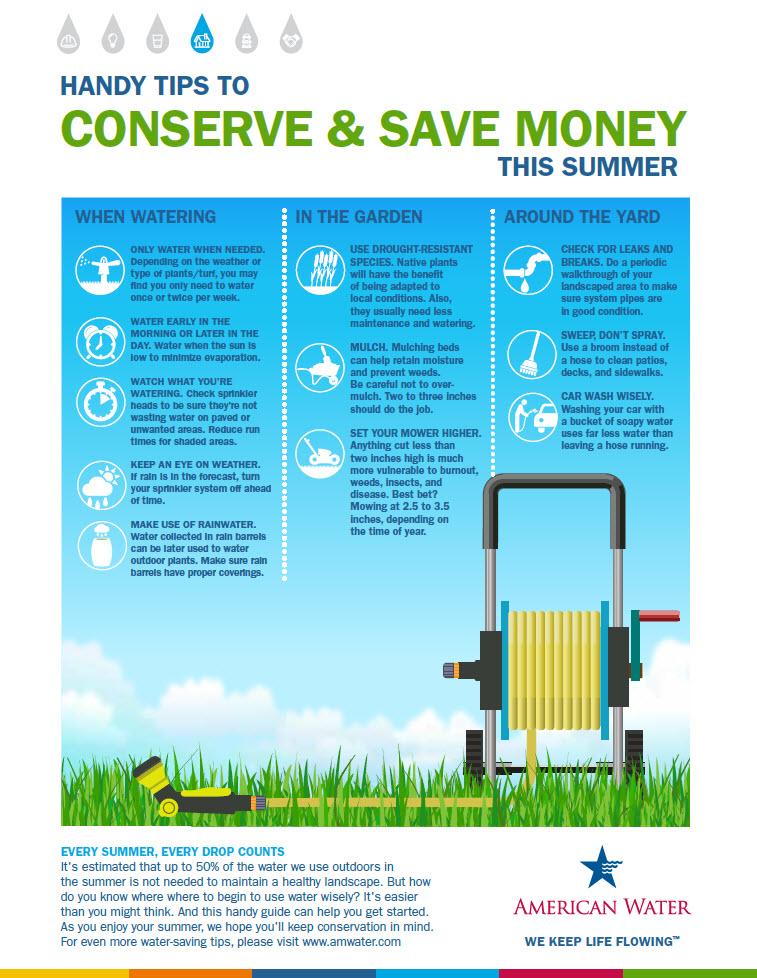1. Water usecalculator
This onlinewater calculator from Alliance for Water Efficiency allows you to input wateruse information specific to your household and offers tips on where you cansave water and energy based on that data.2. Plants
No need to waterevery day. Instead, only water as needed. Depending on the weather or type ofplants/turf, you may find that you only need to water once or twice per week.3. Lawn
Lawn wateringuses a lot of water. Water your lawn only when it needs it. An easy way to tellif your lawn needs water is to simply walk across the grass. If you leavefootprints, your lawn may be thirsty! Generally, lawns only need an inch or soof water per week during the summer months. Set your lawn mower one notchhigher to make your lawn more drought-tolerant.4. Dripirrigation
Use dripirrigation hoses to water plants, and water in the early morning or evening.5. Porouspavement
Consider usingporous pavement (gravel is a good example) instead of asphalt for driveways andwalkways, the rain will soak into the soil instead of running off andcontributing to erosion.6. Broom
Use a broominstead of a hose to clean your sidewalk, driveway, or patio.7. Local plants
Plantappropriately for your local climate. Check with local nurseries fornon-invasive, drought-tolerant plants. Choose drought-resistant plants ornative plants. Plants native to the local conditions have the benefit of beingable to thrive within them. And, they often require less maintenance and water.8. Control theflow
Use a hosenozzle on your hose to better control the flow you are using. Place hosescarefully to avoid watering unnecessary areas like sidewalks.9. Sprinklers
If you use asprinkler, check sprinkler heads to make sure they’re not watering paved orunwanted areas. Be sure to turn them off when it rains.10. Mulch
Mulch plant bedsto reduce weeds and preserve moisture. Over mulching can stress plants - onlytwo to three inches are needed.11. Car wash
Use a bucket ofsoapy water rather than leaving the hose running when washing your car or takeyour car to a car wash that recycles the water.12. Pets
Bathe petsoutdoors in areas that need water.13. Showers
Installwater-saving showerheads and shorten your shower time to five minutes.14. Washers
Run dishwashersand clothes washers only when they are full. If you have a water-saver cycle,use it. Adjust the water level of your clothes washer so it matches your loadsize. If you wash dishes by hand, use two basins: one for washing and one forrinsing. Don’t let the water run. Before washing dishes by hand or in thedishwasher, scrape them; don’t rinse first.15. Leaks
Regularly checkyour toilet, faucets, and pipes for leaks. If you find a leak, have it fixed assoon as possible. Check your water meter before and after a one-hour periodwhen no water is being used. If the meter changes at all, you probably have aleak. Check water bills for any instances of high water use, as this may be anindication of a leak.16.Water-efficient
Consider water andenergy-efficient appliances. Products and services that have earned theWaterSense label have been certified to be at least 20% more efficient withoutsacrificing performance. The USEPA reports that EPA-certified Energy Starwashing machines may use 35% less water per load. Water-saving showerheads,toilets and faucet aerators can also help cut your water usage.17. Insulation
Insulate exposedwater pipes with pre-slit foam insulation. You’ll enjoy hot water faster andavoid wasting water while it heats up.18. Turn it off
Turn off thewater while you are brushing your teeth.19. Running thetap
Keep a pitcherof drinking water in the refrigerator instead of running the tap for a coldglass.20. Rinsing
Rinse vegetablesand fruit in a basin rather than under running water. Defrost frozen foodswithout running water over the packages. Plan ahead and place frozen items inthe refrigerator overnight or defrost them in the microwave.Source:New York American Water | Alliancefor Water EfficiencyRelated Stories8:194d agoThe New Normal: Do we need a third and fourth COVID-19 booster shot?










